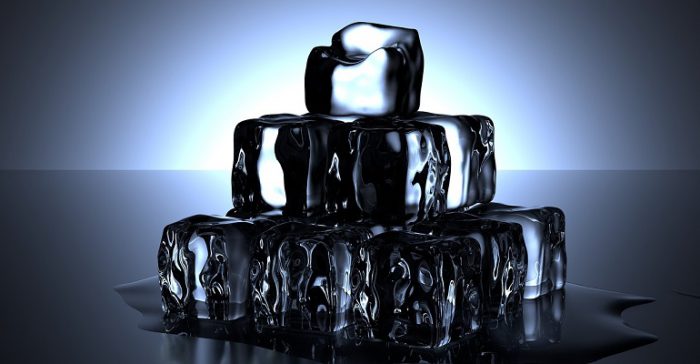Jesse Remillard, ERS, for Zondits. April 5, 2016. Image credit: ColiN00B
Zondits spoke with Michael Hopkins, the CEO of Ice Energy, a Santa Barbara energy storage company which makes smart ice batteries called Ice Bears. These specially designed storage systems are equipped with a reservoir for storing thermal energy in the form of ice, which is created when electricity demand is low, typically at night. The thermal batteries provide cooling during peak hours from the stored ice, when electricity demand is high.

I understand that your product can save customers money. Would you explain how your product does this and what kind of paybacks the Ice Bear can achieve?
The Ice Bear enables the owner to determine when electricity is used for cooling by creating and storing up to 6 hours of cooling that can be delivered on demand with virtually no use of electricity. Most of our sales are megawatt-scale sales to utilities for whom Ice Bear storage can cost-effectively remove the need for traditional grid infrastructure, including peaking power plants, transmission lines, substations, and feeder upgrades. Recently, we have begun selling to commercial and industrial (C&I) customers and homeowners who can lower their utility bill by controlling their peak demand and shifting usage from peak to off-peak. Paybacks can be as low as 3 years, depending on utility rates and incentives.
If most of your sales are to utilities, how does the Ice Bear get in the hands of a user?
When Ice Bears are sold to utilities, they purchase MWs of capacity on a turnkey basis, meaning that we manufacture the number of units needed to deliver that capacity, and then we find and secure locations and install the units. In these utility programs qualifying locations get Ice Bears free of charge.
What makes your product unique compared to other ice storage solutions?
All other ice storage solutions are designed for central chillers in large buildings, which generally have to be designed into the building from the start. Our solution is easily and quickly retrofitted. It is also the only ice storage solution for homes.
What kind of benefits does the Ice Bear offer for homes?
The home Ice Bear provides 24/7 cooling with the ability to stop using electricity for up to 4 hours while still cooling the home. This shifts up to 4 peak hours to off-peak. In addition, because it is ice cooling, no matter how hot it gets – and that includes heat waves – the home gets exactly the cooling desired.
 Can the Ice Bear qualify for energy efficiency or utility incentives?
Can the Ice Bear qualify for energy efficiency or utility incentives?
It qualifies for many incentives, including the Self-Generation Incentive Program in California.
How does the Ice Bear know when grid peak demand levels are occurring?
Each has an onboard monitoring and control system that is connected to the web via a local cellular network, which provides the information it needs to operate to maximize its benefit to the owner.
That’s fantastic. Is the Ice Bear fully automated, then?
Yes.
Are there any operational or equipment life differences between the Ice Bear and a traditional RTU?
The Ice Bear has many similarities to traditional RTUs but has a longer life – at least 20 years. When the Ice Bear is connected to a traditional RTU, it extends that unit’s life by keeping it offline during peak hours (the highest-stress hours for traditional RTUs).
Is there any difference in the maintenance of your system compared to a traditional RTU?
There are no material differences.
What types of facilities are typically good candidates for an Ice Bear?
Any C&I building with rooftop units makes a good candidate, as does any home with central A/C.
Can you explain a little more about what your target characteristics or markets are?
For Ice Bear installation on C&I buildings, the buildings need to have packaged A/C units, be three stories or less, and have the room and structural integrity to support the Ice Bears. If they are to be located on the roof, it needs to support the weight of the Ice Bears, which usually means installing them on the posts. They can alternatively be installed on the ground, next to the building. For residential installation, any home with a 4- to 5-ton outdoor condensing unit should qualify for a home Ice Bear, as it just replaces that outdoor condensing unit.
How will the Ice Bear work in hot climates versus cold climates?
The hotter the better for the Ice Bear, as it displaces traditional A/C during the hottest hours, when traditional A/C would use the most electricity (and in extreme cases would be unable to achieve the desired cooling).
Can you explain how the Ice Bear saves energy despite the inherent losses of storing energy?
The ice Bear has a round-trip efficiency of 85%. In its typical mode of operation, it creates cooling overnight, which is about 15% more efficient than creating the same cooling during the heat of the day. The result is an effective efficiency of 100%.
Thank you so much, Mike, for talking with us about Ice Energy’s products. In closing, can you give us your perspective on the future of ice energy storage?
I believe energy storage will quickly become an integral part of electricity grids worldwide, transforming grids into highly efficient and reliable delivery systems and enabling full adoption of renewables. This will be accomplished by a variety of specialized and cost-effective storage technologies, including ours.
